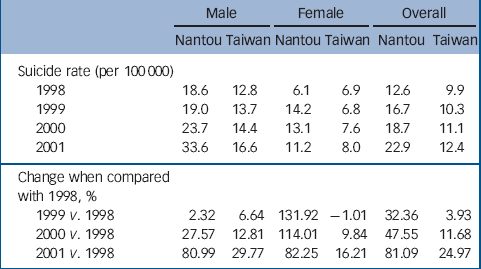The massive earthquake in Sichuan, China, that occurred on 12 May 2008 left 92 000 dead or missing, almost 374 000 injured, and millions homeless.
Rebuilding the communities is a huge task and much is to be learnt from communities with similar experiences. On 21 September 1999, Nantou County in Taiwan experienced an earthquake measuring 7.3 on the Richter scale. It caused more than 2000 deaths, 10 000 injuries and 100 000 collapsed buildings. Reference Han and Chen1 After the earthquake, the number of suicides surged in Nantou. Reference Han and Chen1,Reference Liaw, Wang, Huang, Chang and Lee2,Reference Chou, Huang, Lee, Tsai, Tsay and Chen3 The general patterns of suicide in both regions are similar; Reference Liu, Beautrais, Caine, Chan, Chao and Conwell4,Reference Yip, Liu, Song and Hu5 what happened in Nantou after the earthquake should inform suicide prevention in Sichuan.
Table 1 shows the suicide rates in Nantou before and after 1999. The female suicide rate more than doubled immediately – from 6.1 in 1998 to 14.2 in 1999, whereas a very small increase was observed in males. However, the male suicide rate showed substantial increases in both 2000 and 2001, indicating a delayed effect. On the whole, the rate of increase in Nantou was higher than that in other parts of Taiwan (81% v. 25%).
Table 1 Suicide rate for Nantou County and Taiwan Region before and after the earthquake, 1999

| Male | Female | Overall | |||||||
|---|---|---|---|---|---|---|---|---|---|
| Nantou | Taiwan | Nantou | Taiwan | Nantou | Taiwan | ||||
| Suicide rate (per 100 000) | |||||||||
| 1998 | 18.6 | 12.8 | 6.1 | 6.9 | 12.6 | 9.9 | |||
| 1999 | 19.0 | 13.7 | 14.2 | 6.8 | 16.7 | 10.3 | |||
| 2000 | 23.7 | 14.4 | 13.1 | 7.6 | 18.7 | 11.1 | |||
| 2001 | 33.6 | 16.6 | 11.2 | 8.0 | 22.9 | 12.4 | |||
| Change when compared with 1998, % | |||||||||
| 1999 v. 1998 | 2.32 | 6.64 | 131.92 | –1.01 | 32.36 | 3.93 | |||
| 2000 v. 1998 | 27.57 | 12.81 | 114.01 | 9.84 | 47.55 | 11.68 | |||
| 2001 v. 1998 | 80.99 | 29.77 | 82.25 | 16.21 | 81.09 | 24.97 | |||
The death of one's spouse may trigger suicidal thoughts, especially when compounded with the loss of the major income source. As men are more likely to be the ‘bread winner’ in rural areas, widows might suffer from a profound feeling of hopelessness immediately after a natural disaster. In the case of Sichuan, it is further aggravated by the loss of many children in the collapsed schools, many of them from one-child families (owing to the State's family policy). In contrast, unemployment carries major risk for male suicides; men are likely to be of high risk when the earthquake's impact on the local economy is fully manifested. This can explain the gender difference in the timing of heightened suicide risk in Nantou. It also suggests that the restoration efforts in Sichuan should devote resources to preventing suicide attempts among women in the short term, while devising strategies to prevent further causalities for male suicides before the local economy fully recovers.
Acknowledgements
The author would like to pay tribute to those who have worked tirelessly to save the survivors.




eLetters
No eLetters have been published for this article.